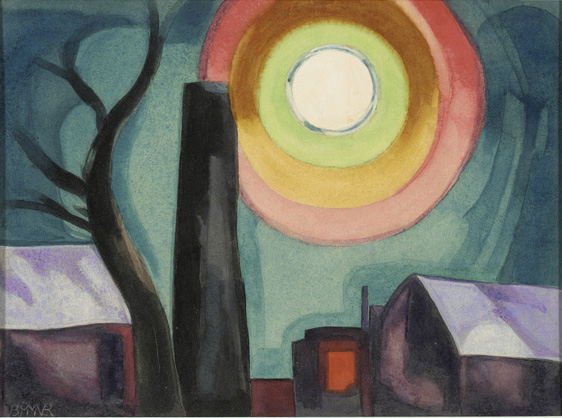
Ascension
Oscar Bluemner
Trained as an architect in Berlin, German-born Bluemner emigrated to the United States in 1892 and began painting the landscapes of New York and New Jersey around 1910. He returned briefly to Europe in 1912, where exposure to various new and daring modes of painting invigorated his own work. Bluemner's significance to the burgeoning modernist movement was marked by his participation in the historic Armory Show of 1913, the event that introduced avant-garde art to American audiences. Bluemner also contributed to the equally groundbreaking Forum Exhibition in 1916, which was vetted by Alfred Stieglitz, the New York gallery owner and tastemaker who championed modernism.
Influenced to a degree by movements such as Cubism, Expressionism, and Orphism, Bluemner's work shows more kinship with artists such as Arthur G. Dove and Charles Burchfield, figures independent of specific movements who regarded landscape painting as a profoundly spiritual exploration. Deeply affected by German Romanticism, especially Goethe, and American writers Emerson and Whitman, Bluemner saw his landscapes as deeply personal visions of external reality. As in many of Bluemner's mature works, "Ascension" assembles geometric divisions of intense color into simple architectonic forms within a fantastic landscape, all bathed in a mystical glow.
Artist
Date of Birth
(1867-1938)
Date
1927
Medium
Watercolor and chinese white on wove paper
Dimensions
10 1/4 x 15 5/16 in. irr. (26.035 x 38.8874 cm.)
Accession #
1988.5
Credit Line
John S. Phillips Fund
Copyright
No known copyright restrictions
Category
Subject
More by
We're so excited you're planning to visit PAFA!
Make time for art — visit us Thursday to Sunday.
Before reserving your tickets, please review helpful information about museum hours, accessibility, building access, and special admission programs.
If you have any questions, feel free to reach out to us at visitorservices@pafa.org — we’d love to help!